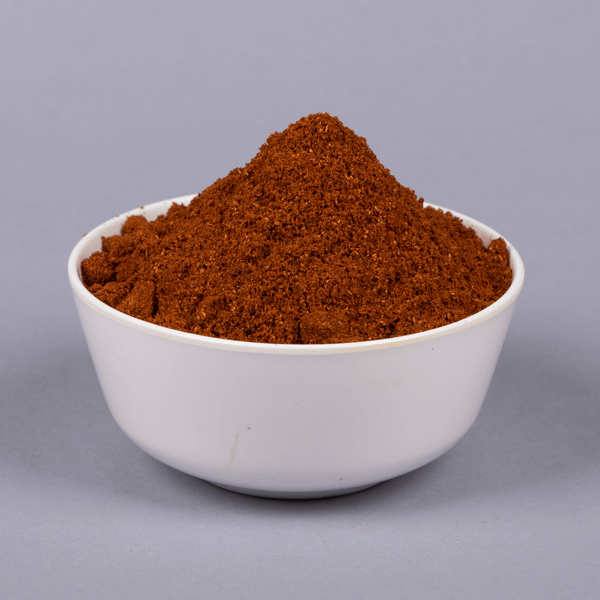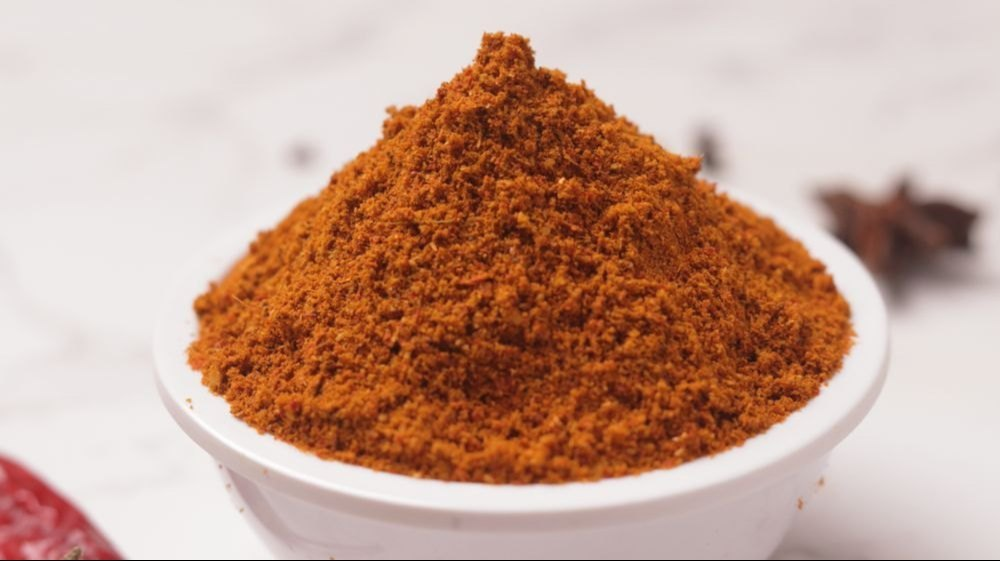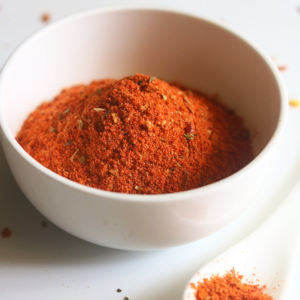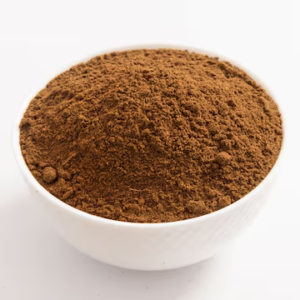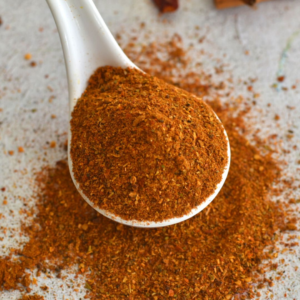Description
Key Ingredients in Pav Bhaji Masala:
Pav Bhaji masala typically contains a variety of spices that provide warmth, earthiness, and a touch of tanginess. The most common ingredients in pav bhaji masala include:
- Coriander Seeds: Coriander has a mild citrusy flavor and provides a sweet, aromatic base to the masala.
- Cumin Seeds: Cumin brings an earthy, slightly nutty flavor, adding a grounding base to the spice mix.
- Dry Red Chilies: These are used to add the signature heat and a touch of smokiness to the bhaji.
- Turmeric: Turmeric imparts a mild bitterness and vibrant yellow color, making the bhaji more visually appealing and providing depth to the flavor.
- Ginger: Dried ginger or ginger powder adds warmth and slight heat, complementing the spices.
- Cinnamon: A small amount of cinnamon provides warmth and a slight sweetness to the mix.
- Cloves: Cloves are used sparingly, offering a strong, aromatic, and slightly sweet-spicy flavor that deepens the overall profile.
- Fennel Seeds: Fennel provides a mild sweetness with a slight licorice flavor, balancing the heat from the chilies and the richness of the dish.
- Black Salt: Black salt adds a distinctive minerally flavor and slight tanginess to the mix, enhancing the overall complexity.
- Bay Leaves: Bay leaves contribute a subtle herbal, slightly bitter note to the masala blend.
- Amchur (Dry Mango Powder): Amchur powder adds a tangy, fruity sourness that helps to balance the richness of the other spices and the cooked vegetables.
- Kasuri Methi (Dried Fenugreek Leaves): A pinch of kasuri methi can be added to the masala for a herbal, slightly bitter flavor that enhances the taste of the bhaji.
- Asafoetida (Hing): A small amount of hing (asafoetida) is sometimes added for its savory, umami flavor, which enhances digestion and balances the dish.
Flavor Profile:
- Earthy and Aromatic: The combination of cumin, coriander, and fennel seeds creates a warm, aromatic base for the pav bhaji.
- Spicy and Pungent: Red chilies, black salt, and ginger provide a balanced heat without overpowering the dish.
- Tangy: Ingredients like amchur (dry mango powder) and black salt lend a tangy element that balances the richness of the mashed vegetables.
- Warm and Slightly Sweet: Cinnamon and cloves provide a background warmth, with a subtle sweetness that harmonizes with the savory elements.
- Herbal: The addition of bay leaves and kasuri methi adds an herbaceous quality that elevates the dish’s flavor.
Common Uses:
Pav Bhaji Masala is used primarily in the preparation of pav bhaji, but it can also enhance other dishes. Here are the main uses:
- Pav Bhaji: The primary use of pav bhaji masala is in the preparation of pav bhaji itself. The masala is added to a mixture of mashed vegetables (such as potatoes, tomatoes, peas, carrots, and bell peppers) along with other ingredients like onions, garlic, ginger, and tomatoes. It infuses the bhaji with a complex, layered flavor profile. The bhaji is typically served with pav (bread rolls), which are toasted with butter and used to scoop up the curry.
- Vegetable Curries: You can use pav bhaji masala to flavor other vegetable curries. It’s great for spicing up dishes like aloo gobi (potato and cauliflower curry) or mixed vegetable curry.
- Sandwiches and Wraps: The masala can be added to spiced vegetable fillings for sandwiches or wraps. It’s a great way to add flavor to simple dishes or snacks.
- Rice Dishes: Pav bhaji masala can be added to rice dishes, such as pulao or biryani, to give them an aromatic, spiced twist.
- Tikka or Kebab Marinades: This masala can also be used in marinades for grilling or roasting vegetables, tofu, or paneer (Indian cottage cheese), enhancing their flavor with its warm spices.
Health Benefits (Claimed):
The spices in pav bhaji masala are not only flavorful but are also associated with various traditional health benefits:
- Digestive Aid: Many of the spices, such as cumin, ginger, and coriander, are known for their digestive benefits, helping to ease bloating and improve digestion.
- Anti-inflammatory: Ingredients like turmeric and ginger have anti-inflammatory properties, which may help reduce inflammation in the body.
- Rich in Antioxidants: Several of the spices, including cinnamon, cloves, and turmeric, contain antioxidants that help protect the body from oxidative damage caused by free radicals.
- Boosts Immunity: Cumin, turmeric, and ginger are believed to have immune-boosting properties, supporting the body in warding off infections.
- Anti-nausea and Anti-bloating: Asafoetida and ginger are traditionally used to relieve nausea and bloating, making the pav bhaji a soothing and beneficial dish.
Regional Variations:
While pav bhaji masala is most commonly associated with Mumbai-style pav bhaji, there are some regional variations in the ingredients and preparation of the masala:
- Mumbai Pav Bhaji: The most famous version of pav bhaji, typically using a combination of the spices mentioned above, with a rich, buttery flavor and tangy notes from the tamarind.
- Maharashtrian Variations: In Maharashtra, the masala can sometimes be made with a more intense flavor profile, featuring more chili powder or even curry leaves for added fragrance.
- Southern Variations: In South India, a slightly different mix of spices might be used, with curry leaves and mustard seeds added for more local flavors.
How to Make Pav Bhaji Masala:
While you can buy ready-made pav bhaji masala from stores, making it at home allows you to adjust the flavors to your taste. Here’s how you can prepare it:
- Roast the Whole Spices: In a dry pan, lightly roast the coriander seeds, cumin seeds, fennel seeds, dry red chilies, and bay leaves until fragrant (be careful not to burn them).
- Grind the Spices: Allow the roasted spices to cool, then grind them into a fine powder using a spice grinder or mortar and pestle.
- Mix with Other Ingredients: Add turmeric, ginger powder, cinnamon, cloves, amchur (dry mango powder), kasuri methi (optional), and black salt to the ground spice mix. Stir well to combine.
- Store: Store the homemade pav bhaji masala in an airtight container in a cool, dry place for future use.
Conclusion:
Pav Bhaji Masala is an essential spice blend that imparts the distinct, comforting flavor of pav bhaji, a quintessential street food from Mumbai. With its rich mix of aromatic spices, tangy notes, and just the right amount of heat, it brings a vibrant flavor to the mashed vegetable curry, making it a beloved dish across India and beyond. Whether used in the traditional pav bhaji or in other vegetable curries, rice dishes, or snacks, this masala blend is an indispensable part of Indian cooking that adds warmth, depth, and spice to any meal.


